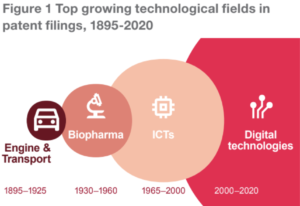AI Innovations will Lead to a Tsunami of IP Rights
Technological Cycles
Technological cycles have been accompanied by significant spikes in inventions, intellectual property rights (IP) and economic value creation, but none of these prior cycles will compare to the scale of innovations and IP to be created during the next cycle – the AI technological cycle.

WIPO Report 2022, “The Direction of Innovation,” pg. 8.[1]
While AI has been around for over 40 years, the real breakthrough for AI only occurred 6 years ago with the invention of the transformer architecture for large language models that enabled generative AI applications. OpenAI’s ChatGPT was released just over a year ago, and took full advantage of this innovation, capturing world attention, setting the stage for accelerating uses of generative AI and a tsunami of innovations at every level of the full AI stack necessary to improve functionality, performance and cost advantages. These innovations will capture enormous economic value, provide product differentiation and will be protected by IP rights.
First Mover Stage
The current stage of the AI technological cycle is still mainly the “first mover stage.” During this stage, first movers are the early adopters, utilizing technology but still experimenting with its use-cases and potential scale. In this phase, there is not yet a single dominant provider that owns an entire vertical slice or a particular horizontal level of the AI stack, with the exception perhaps of Nvidia’s first mover dominance over GPUs. But AMD has introduced its own competitive AI chips and the cloud providers (e.g., Amazon Web Services (AWS), Microsoft Azure, Google Cloud Platform) are doing their best not to be captive to a single chip supplier. They have been deploying their own proprietary GPUs (e.g., Inferentia and Trainium (AWS), Tensor (Google) and others), as well as using Nvidia’s GPUs.
While some of the traditional economic barriers to entry exist at this early stage, like the scale of the big three cloud providers’ enormous buying power for GPUs, this type of early economic moat will last so long as capital is scarce and alternative chip supply is not available. Many of the AI models made available at the cloud provider level are open-source and available to everyone. At the application level, B2B and B2C applications rely on these open-source AI models to limit their development expenses (e.g., AI engineering talent is scarce, computing costs for training and fine tuning are high, etc.) and shortcut time to market. But these applications end up looking very similar to one another based on their feature set and efficiency because they use the same or similar AI models, run on the same datasets (e.g. the internet) with the same or similar architectures and have the same efficiency since they run on cloud provider servers using the same GPUs.
Cloud providers running open-source AI models are vulnerable too. Since the GPUs are the same or similar across the cloud providers, performance of these platforms cannot be materially differentiated. Additionally, since the AI model’s APIs across these cloud platforms are essentially the same, the switching costs between cloud providers for AI application developers is low. AI application developers will necessarily search for the lowest cost alternative to create sustainable business models with gross margins and swap between cloud providers.
Innovation Stage
As we move past this “first mover stage”, we’ll begin seeing the first “tsunami” of innovations with the introduction of new proprietary technologies, systems and infrastructure that substantially advance the efficiency, performance and/or usability at and between each level of the AI stack. These unique innovations will provide AI companies with product differentiation and longer term, durable barriers to entry in the form of IP rights. AI models populated with unique data and/or weights, and/or ones that have unique architectures (e.g. chip designs) that provide computational efficiencies for training, fine tuning, embedding and prompting will likely be examples of such innovations for which valuable IP rights will be applicable. While there are a variety of IP rights (©, trade secrets and patents) that may be applicable to the AI innovations, by far patent rights are the most formidable and valuable. In our next blog, we will address why we believe there will be a tremendous spike in patent filings associated with this next wave in AI innovation.
[1] Prior technological cycles include the windmill, electricity, light bulb, combustion engine, assembly line, pharmaceuticals, computer, microchip, internet, information and communication technologies (ICTs) wireless protocols, etc.

